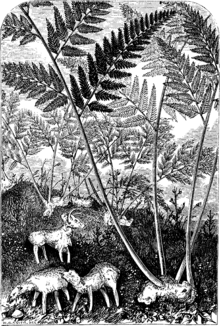- Cibotium barometz
-
Cibotium barometz 
The "Vegetable Lamb of Tartary" from Svenska Familj-Journalen, 1879 Scientific classification Kingdom: Plantae Division: Pteridophyta Class: Pteridopsida Order: Cyatheales Family: Dicksoniaceae Genus: Cibotium Species: C. barometz Binomial name Cibotium barometz
(L.) J.Sm.Synonyms Polypodium barometz L.
Cibotium barometz, golden chicken fern, woolly fern, is a species of tree fern native to parts of China and to the western part of the Malay Peninsula. The fern's woolly rhizome was thought to be the inspiration for the mythical "Vegetable Lamb of Tartary".
Description and distribution
Cibotium barometz is in the fern family Dicksoniaceae[1] and is one of a small number of tree fern species that Carl Linnaeus initially placed in the fern family Polypodiaceae in his Species Plantarum.[1]
C. barometz is native to parts of China and to the western part of the Malay Peninsula. The plant grows only to a height of 1 m (3 ft 3 in), when erect, but is often prostrate, forming colonies of plants on open forest slopes and in disturbed areas. The fronds are up to 3 m (10 ft) long. The sori are marginal on the pinnules.
The species is a folk medicinal herb in common use. It was thought to be the mythical "Vegetable Lamb of Tartary" during the Middle Ages due to the resemblance of its woolly rhizomes to a lamb.[1][2] Although it is widely distributed, the plant has been extensively collected in Southeast Asia, causing the decline in the population size and number of individuals.
References
Categories:- Fern stubs
- Cibotium
- Fern species
- Pteridophyta of Asia
- Flora of Southeast Asia
Wikimedia Foundation. 2010.
